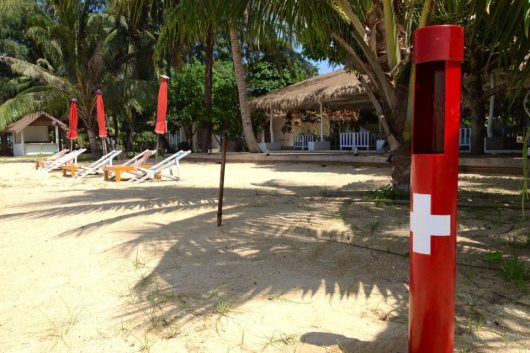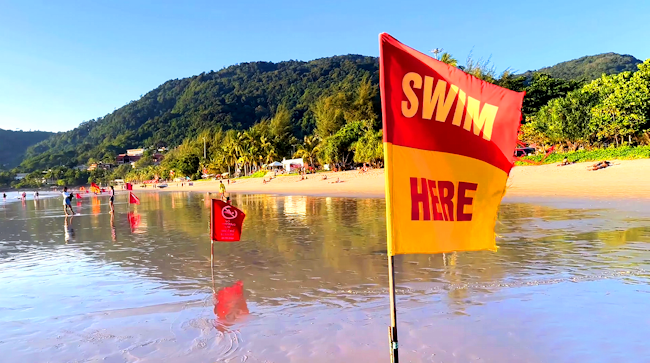Thailand’s beaches may be beautiful, the clear pristine water is inviting, but don’t let this image of serenity lull you into a false sense of security. If you see a red flag, a red and yellow flag, a yellow flag, a black and white checkered flag or a green flag on any beach in Thailand, you need to pay attention!
A RED Flag means DO NOT ENTER THE WATER (high hazard). The penalty for ignoring this flag can be death.
A YELLOW Flag means Medium Hazard. Moderate Surf and/or currents. If you are not a strong swimmer, stay out of the deep water.
A BLACK/WHITE CHECKERED Flag means there are watercraft or surfboards in the area. It is very easy to get hit by a jet-ski or surfboard which can cause major injuries.
A GREEN Flag means LOW HAZARD and Calm Conditions and it is ok to swim.
A RED/YELLOW Flag means it is a lifeguard patrolled area. Once again, if you are not a strong swimmer, best to stay in an area where you can be rescued by a lifeguard.
RIP TIDES/CURRENTS are very prevalent in Thailand. The tide will pull you forcefully away from shore. This is the number 1 drowning hazard in Thailand. If you did not grow up near the beach or understand what a RIP TIDE/CURRENT is, educate yourself and your family before someone drowns!
This link provides an excellent education how to spot a rip current and how to get out a rip current without drowning.
How to Survive a Rip Current:
- Relax. Rip currents don’t pull you under.
- A rip current is a natural treadmill that travels an average speed of 1-2 feet per second, but has been measured as fast as 8 feet per second — faster than an Olympic swimmer. Trying to swim against a rip current will only use up your energy; energy you need to survive and escape the rip current.
- Do NOT try to swim directly into to shore. Swim along the shoreline until you escape the current’s pull. When free from the pull of the current, swim at an angle away from the current toward shore.
- If you feel you can’t reach shore, relax, face the shore, and call or wave for help. Remember: If in doubt, don’t go out!
- If at all possible, only swim at beaches with lifeguards.
- If you choose to swim on beaches without a lifeguard, never swim alone. Take a friend and have that person take a cell phone so that person can call for help.
Another issue to be aware of is Jellyfish. 100’s of tourists are stung by jellyfish each year on Thai Beaches and it is very painful.
Some beaches have vinegar stations set up to easy the pain of the jellyfish sting.

You should ask your accommodation or the lifeguards if there are any jellyfish in the swimming area. If the answer is yes, bring your own supply of vinegar if the even you get stung.



